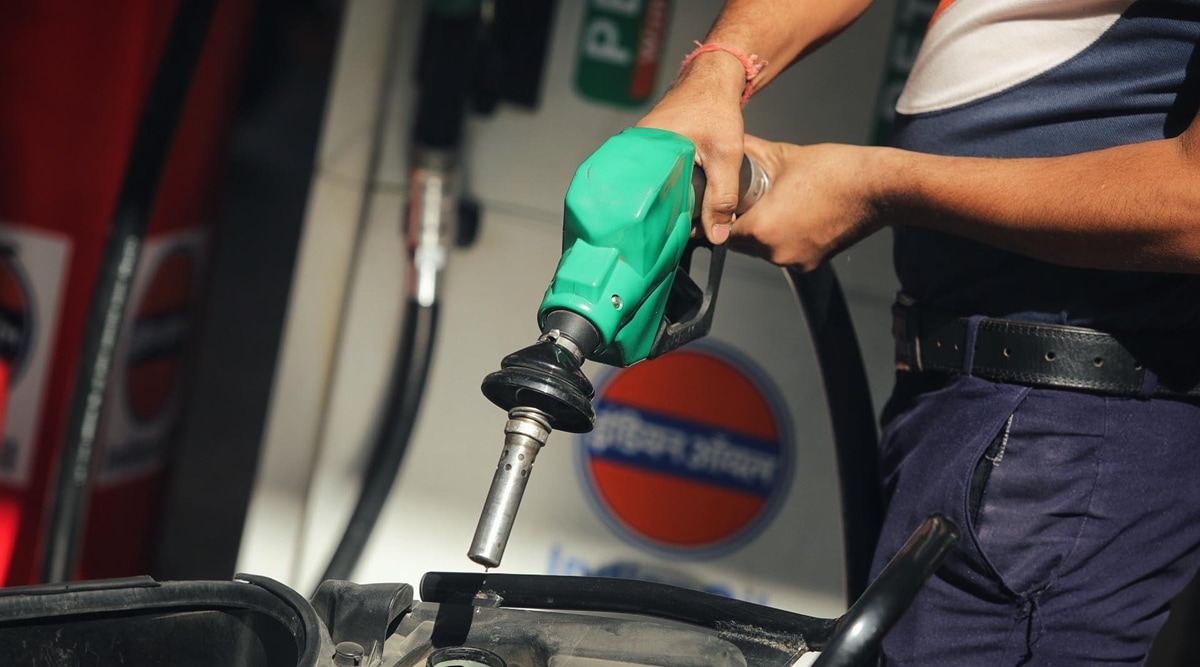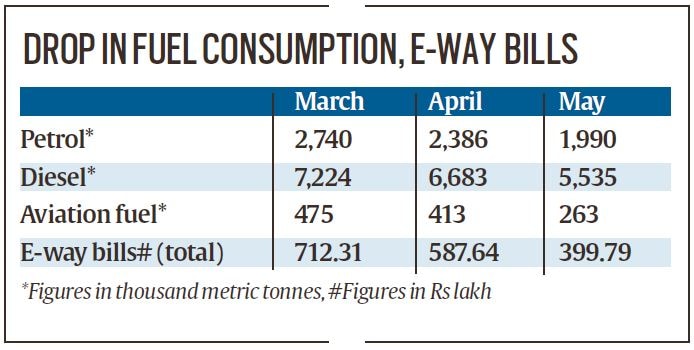 A worker fills petrol for two wheelers at a fuel station in Ahmedabad. (Express photo by Nirmal Harindran)
A worker fills petrol for two wheelers at a fuel station in Ahmedabad. (Express photo by Nirmal Harindran) SIGNALLING the impact of the second wave of Covid infections on the economy, with most states putting in place stringent curbs on movement, the consumption of fuel — diesel, petrol and aviation fuel — fell by 25 per cent from March, the month before the surge, to May, official figures show.
During the same period, figures compiled by transporters show, e-way bills generated to carry goods also fell by 45 per cent, mainly due to restrictions on movement of vehicles within states.
According to figures compiled by the Centre’s Petroleum Planning and Analysis Cell (PPAC), the consumption of air fuel saw the maximum drop: 4,75,000 MT in March, 4,13,000 MT in April and 2,63,000 MT in May, when the full impact of the second wave and air travel curbs imposed by at least nine countries were felt in the aviation sector.
As state after state started to impose restrictions, the consumption of petrol dropped by over 27 per cent across the country between March and May: 27,40,000 MT (March), 23,86,000 MT (April) and 19,90,000 MT (May). The drop comes at a time when petrol prices have also soared, crossing Rs 100 per litre in Mumbai and Rs 95 per litre in Delhi.
Diesel, which is used more by heavy vehicles carrying goods, saw consumption fall by 23.4 per cent between March and May, the least among the three fuels: 72,24,000 MT of high speed diesel in March, 66,83,000 MT in April and 55,35,000 MT in May.

Put together, 1,04,39,000 MT of petrol, diesel and aviation fuel were consumed in March, which fell almost 10 per cent to 94,82,000 MT in April and 25 per cent to 77,89,000 MT in May.
After the national lockdown imposed in March last year, consumption of the three fuels – used in most private and commercial, passenger and goods vehicles, aircraft, and generators – totalled 73,75,000 MT in May 2020. That was nearly double of 42,79,000 MT in April 2020, but much less than February’s 1,03,61,000 MT.
This year, another indicator of the contraction in economic activity in May is the number of e-way bills generated, which is necessary to transport goods worth more than Rs 50,000.
According to data compiled by the All India Transporters Welfare Association, one of the largest associations of road transporters in the country, the total number of e-way bills generated fell by nearly 45 per cent from 7.12 crore in March to 3.99 crore in May. In April, 5.88 crore e-way bills were generated.
The drop in e-way bills generated daily came down from 23 lakh in March to 20 lakh in April and just 13 lakh in May, the figures show.
According to the data, intra-state e-way bills fell more sharply than those for inter-state travel, which had no restrictions. May is the first month over the last year when the number of intra-state e-way bills was fewer than those generated for inter-state.
For intra-state e-way bills, 13.82 lakh were generated daily on an average in March, coming down slightly to 11.93 lakh a day in April. In May, it fell by 60 per cent from April to just 4.78 lakh per day, on an average.
In comparison, inter-state e-way bills generated per day saw only a marginal decline, coming down from 9.16 lakh in March to 7.66 lakh in April — it actually went up to 8.11 lakh in May.
After the national lockdown last year, the number of e-way bills generated was 86 lakh in April 2020 and 2.55 crore in May.
- The Indian Express website has been rated GREEN for its credibility and trustworthiness by Newsguard, a global service that rates news sources for their journalistic standards.

